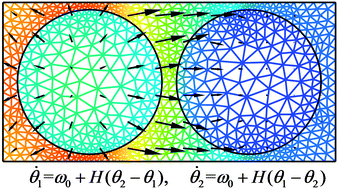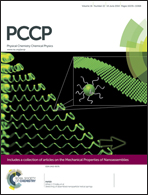Combined excitatory and inhibitory coupling in a 1-D array of Belousov–Zhabotinsky droplets
Abstract
We study the dynamical behavior of one-dimensional arrays of ∼100 μm diameter aqueous droplets containing the oscillatory Belousov–Zhabotinsky (BZ) reaction, separated by narrow gaps of a fluorinated oil. In this closed system, the malonic acid concentration decreases as the reaction proceeds. Starting with a low initial malonic acid concentration, we observe a series of attractors as a function of time in the following order: anti-phase attractors; in-phase attractors, which evolve into traveling waves; and mixed modes that contain either regions of in-phase droplets separated by anti-phase oscillators, or in-phase oscillators combined with non-oscillatory droplets. Most of the observations are consistent with numerical chemical models of the BZ reaction in which components that participate in the excitatory (bromine dioxide and bromous acid) and inhibitory (bromine) pathways diffuse between the droplets. The models are used to quantitatively assess the inter-drop coupling strength as a function of drop separation, drop size and malonic acid concentration. To experimentally establish the mechanism of excitatory coupling between the BZ droplets, we verify the transport through the fluorinated oil of chlorine dioxide and several weak acids, including malonic acid.


 Please wait while we load your content...
Please wait while we load your content...